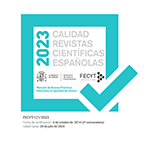The architecture of Upper California’s missions. A tool in production and spiritual control
Abstract
The twenty-one missions in Upper California were the first test of shared community life by Spaniards and the native population there. The presence of these missions contributed to the emergence of new types of architecture and to big social changes. The purpose of this paper is to analyse some important features of this architecture that largely influenced the latter's role as a tool in evangelization and in controlling the native population. The methodology that was used, supported by an extensive bibliography and documentary sources, consisted of an analysis of plans, paintings and photographs from different eras, combined with fieldwork at some missions.
Among other results, we highlight the idea that the missions' design was determined by religious and production activities, giving priority, on the one hand, to the religious community's wellbeing over that of the native population and, on the other, to the use of inner areas as opposed to outer ones. Secularization, in 1833, led to a halt in the missions' activities, plunging them into a state of neglect which persisted through to the beginning of restoration work in the 20th century. These missions are now tourist and cultural attractions, visited by tourists and students who interpret the early history of a state characterized by its colonization.
Downloads
Article download
License
In order to support the global exchange of knowledge, the journal Arte, Individuo y Sociedad is allowing unrestricted access to its content as from its publication in this electronic edition, and as such it is an open-access journal. The originals published in this journal are the property of the Complutense University of Madrid and any reproduction thereof in full or in part must cite the source. All content is distributed under a Creative Commons Attribution 4.0 use and distribution licence (CC BY 4.0). This circumstance must be expressly stated in these terms where necessary. You can view the summary and the complete legal text of the licence.










